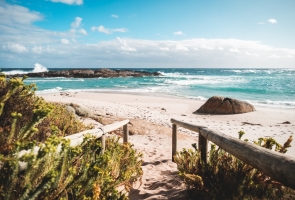Travel can be a touchy subject right now, but it’s still a valuable and marketable subject area when approached from the right perspective. Since COVID-19 is still having a major impact in parts of the world, attitudes toward travel vary, as do regulations that limit where people can go in the first place. It can be a tricky thing to come up with content that encourages the very thing that pays the bills.
Before you pack it in and try to tap an entirely different content area, please keep a few things in mind. For starters, COVID might seem like an endless situation, but it isn’t. All pandemics start and end, and this one will be no different. Second, just because people aren’t traveling as much doesn’t mean that interest in quality travel content has diminished. In fact, many people are making long-term plans for future trips and will likely have larger travel budgets if they skipped traveling in 2020.
Lastly, travel content doesn’t have to be specifically about traveling. There are so many subtopics you could be split-testing that it might be time to expand your subject areas a bit and see what specific kinds of content appeal to your readers. One niche content area that builds trust with readers is education. That’s true regardless of your specific subject.
Educating your readers makes them view you as not only a thought leader but also one who understands them and the things that are important to them. Being safe during a pandemic is a great avenue of education that can help you maintain or gain ground in any travel marketing niche. With that in mind, here are a few education-based travel content areas to consider when developing your blog for at least the first half of 2021 (and likely beyond).
Know the Destinations You Recommend
This is the most important thing you can do for your readers right now. Anyone can research the basics about the destination (restaurants, attractions, etc.), but right now, basic just won’t cut it. If you intend to continue destination blogging, it is very important to know how that destination is dealing with COVID. Is travel there even allowed right now for members of your core audience? What kinds of regulations can they expect? What is actually open? Where can they go to minimize contact with strangers?
These questions and more must find their way into your destination blog. Don’t motivate people to make irresponsible or impossible plans. This creates confusion and frustration for readers who then start researching trips to places they either cannot go or wouldn’t be able to fully enjoy once they got there.
Do also think long-term, though, and blog about those attractions and restaurants. Remember, people are making long-term plans and also want things they can look forward to. It’s a fine balance, but don’t look at the content you’re publishing now as evergreen. It’s going to have a shelf life, but it will also reinforce your brand if it’s well-presented and communicates responsible information for the time during which it is written.
Include Safety Guidelines in All Blog and Social Media Posts
Don’t think that people have already heard enough about travel safety. In the context of things they want to research, safety information is more valued and will be more readily retained. Anyone who is seriously thinking about traveling, either for business or pleasure, wants to stay safe. Emphasize things like social distancing and wearing a mask and make it clear that these are still the frontline defenses against COVID-19. It won’t come across as repetitive if it is relevant to the other information in the post.
Being safety-centric is also another thing that builds trust from your readers. Today’s content consumers like the idea of the bloggers and brands they support having their backs. Don’t be preachy, just practical. “If you go here, masking will be mandatory.” That applies to almost anywhere right now, of course, but keeping it in the front of the reader’s mind can help discourage noncompliance.
Recommend In-State Destinations
Right now, the concept of a staycation is more prevalent than in the recent past. You may also want to research states that still have a decent quorum of current recreation offerings and market them appropriately. It is important to know the regulations for individual states at the time of writing and mention them.
Can out-of-staters visit these destinations at the moment? If not, you might want to consider blogging to locals and to those who can only plan in-state travel. This is where understanding longtail keywords and other areas of local SEO come in handy. This is a difficult niche to penetrate, but with the right SEO strategy in place, coupled with an appropriate social media presence, it is definitely workable.
Facilitate Researching Travel Plans in Advance
Much of what we’ve already discussed has revolved around this concept, but we haven’t talked about the most important element to it: clear calls to action. Remember, readers aren’t likely to just act on the information in your blog even if they are already fans and already trust you and your messaging.
Calls to action are vital to ensuring that people do what you want them to with the content. Don’t exclusively rely on marketing CTAs. Develop CTA messaging that has direct personal benefit to the reader. This will help them get the absolute most out of your content and motivate them to not only follow your calls to action but also keep them coming back for more.
Blog About State Guidelines
You can also expand on the concept of mentioning state travel guidelines beyond who can come and go. If your readers are planning out-of-state travel, good content coupled with authoritative links will have the maximum benefit. Be thorough and explain the current travel guidelines for each state. You can expand it further by researching specific destinations. Report on how they are handling COVID concerns and what is expected of visitors while on-property.
If some of these ideas seem a little bland, you’re right. Making the content interesting requires both an understanding of your audience and the ability to engage even on subjects that people don’t really want to think about, like COVID-19. The thing about that is that people, particularly travelers, need to be thinking about them.
If you need help making your content more engaging while maintaining a level of responsible content creation that builds trust in your content, contact us. At BeezContent, we know travel content, and we know how to produce high-quality, engaging content that generates the kinds of conversions you specify. Talk to us today about your travel content creation needs, and let’s come up with a winning strategy together!




